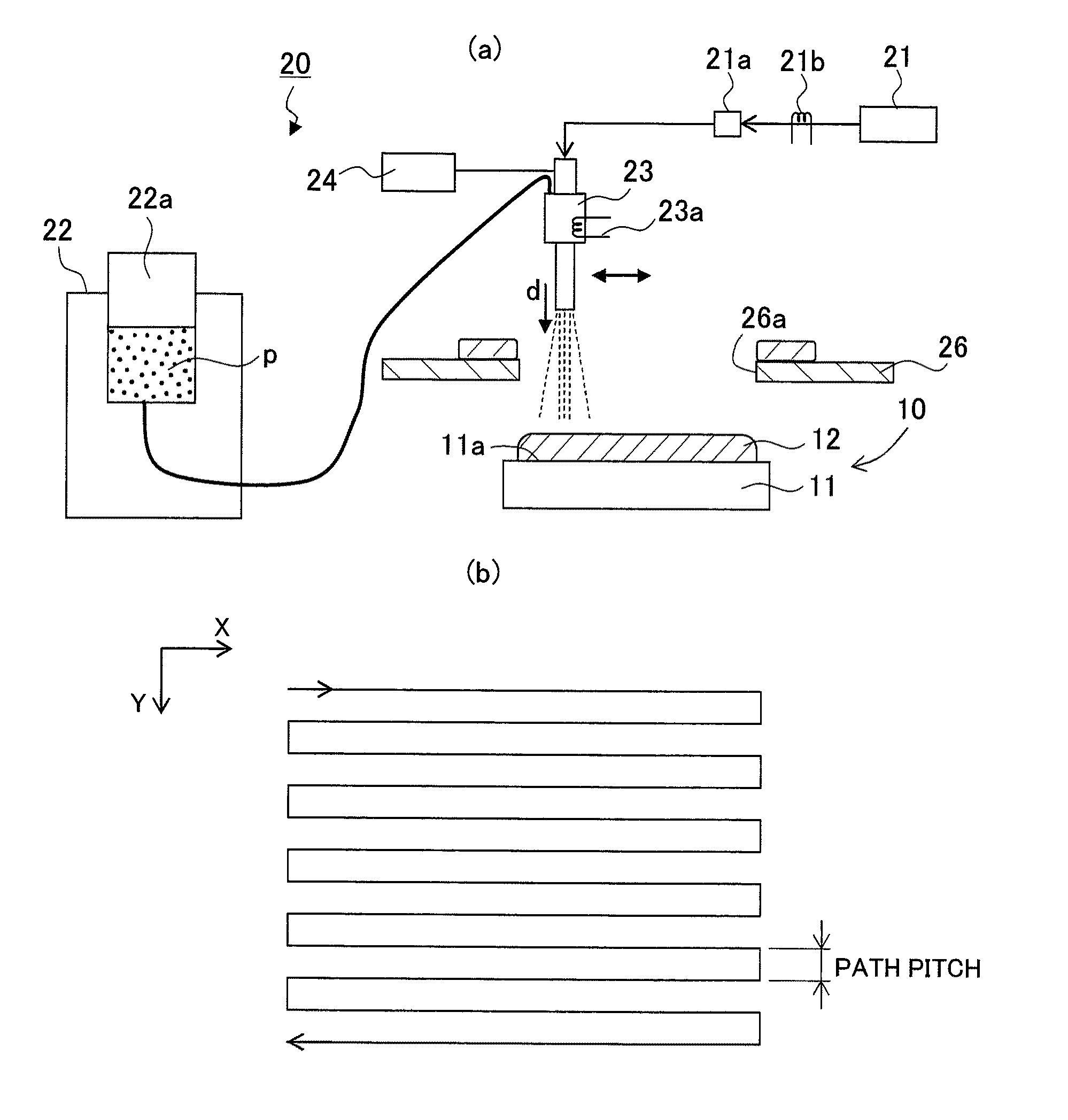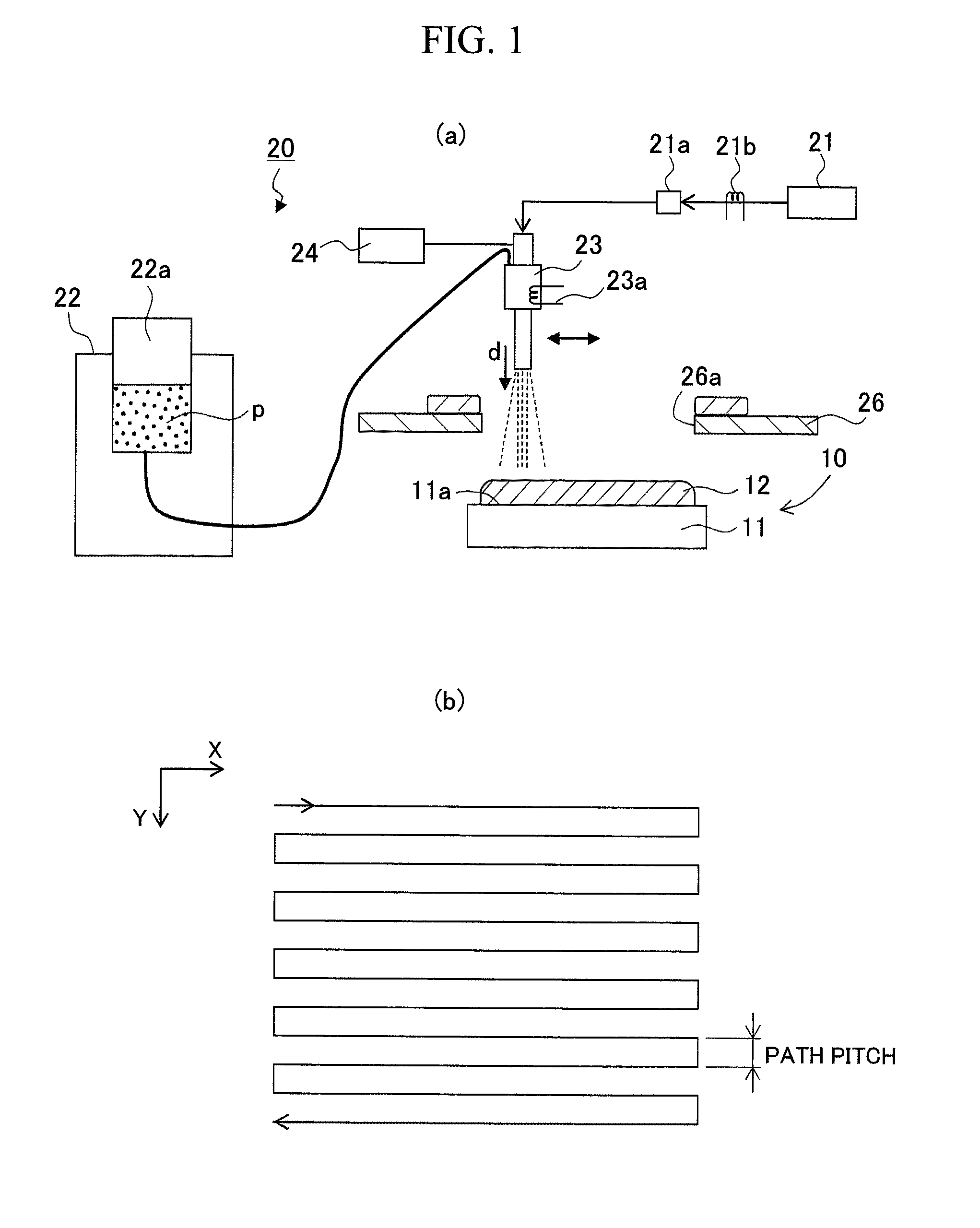Method of forming a metal powder film a thermal conduction member, power module, vehicle inverter, and vehicle formed thereof
a metal powder and thermal conduction technology, applied in the field of metal powder, can solve the problems of increasing the cost of film forming facilities and the cost of compressed gas for use, low adhesion efficiency, and difficulty in forming a desired porous film having multi-functionality, etc., to achieve the effect of increasing the transformation of metal powder, enhancing adhesion efficiency, and low cos
- Summary
- Abstract
- Description
- Claims
- Application Information
AI Technical Summary
Benefits of technology
Problems solved by technology
Method used
Image
Examples
example 1
[0056]A thermal conduction member was produced where a copper film had been formed on a substrate by cold spraying. Specifically, the air (atmospheric air) is compressed such that a density of the copper film was 7.8 kg / m3 (holes: 12% by volume), and a metal powder made of copper, which was in a solid-phase state, was sprayed to the surface of a heat sink member (substrate) made of an aluminum alloy of 30×20 mm in size and 5 mm in thickness (HS standard: A6063S-T1), along with the compressed air (compressed gas), so that a film was formed using the copper powder, and a thermal conduction member was produced.
[0057]A more detailed description is given below: a nozzle for spraying was arranged in a position 30 mm from the top of the heat sink member where surface processing had been performed by shot-blasting, through a masking plate having an opening for masking of 30×20 mm in size. Next, as shown in a table of FIG. 4, a copper powder for film formation was granulated from a water-ato...
examples 2 to 5
[0058]In the same manner as in Example 1, a film of the copper powder was formed on the surface of the substrate. A different point from Example 1 is a powder used at the time of film formation. Specifically, as shown in FIG. 4, in Example 2, a powder was used having been granulated from a gas-atomized powder, milled by a nitrogen gas, made of copper and having a grain size of 3 μm, so as to have an average grain size of 18 μm and an apparent density of 1.88 g / cm3 as a copper powder for film formation. In Examples 3 and 4, powders were used having been sequentially granulated from an electrolytic powder, made of copper and having a grain size of 4.8 μm, so as to have average grain sizes of 22 μm and 21 μm and dummy densities of 1.64 g / cm3 and 1.5 g / cm3, as copper powders for film formation. Further, in Example 5, a dendritic powder having an average grain size of 19.3 μm and an apparent density of 1.64 g / cm3, shown in FIG. 5(a) was used as an electrolytic powder. The adhesion effici...
example 6
[0066]A thermal conduction member was produced in the same manner as in Example 1. A different point from Example 1 is that a film was formed on a temperature condition of the copper powder, immediately before collided with the substrate, of not lower than 50° C., shown in FIG. 8. A thermal conductivity of the film was then measured in the same manner as in Example 1. Results of the measurement are shown in FIG. 8.
PUM
| Property | Measurement | Unit |
|---|---|---|
| grain size | aaaaa | aaaaa |
| apparent density | aaaaa | aaaaa |
| pressure | aaaaa | aaaaa |
Abstract
Description
Claims
Application Information
 Login to View More
Login to View More - R&D
- Intellectual Property
- Life Sciences
- Materials
- Tech Scout
- Unparalleled Data Quality
- Higher Quality Content
- 60% Fewer Hallucinations
Browse by: Latest US Patents, China's latest patents, Technical Efficacy Thesaurus, Application Domain, Technology Topic, Popular Technical Reports.
© 2025 PatSnap. All rights reserved.Legal|Privacy policy|Modern Slavery Act Transparency Statement|Sitemap|About US| Contact US: help@patsnap.com



